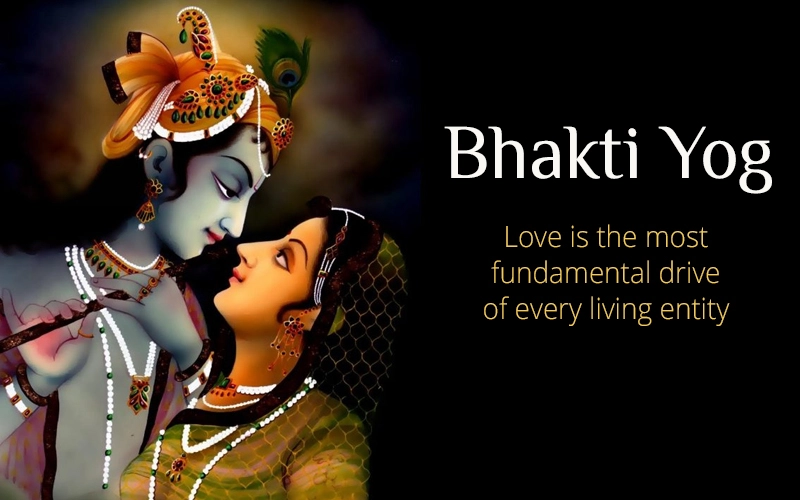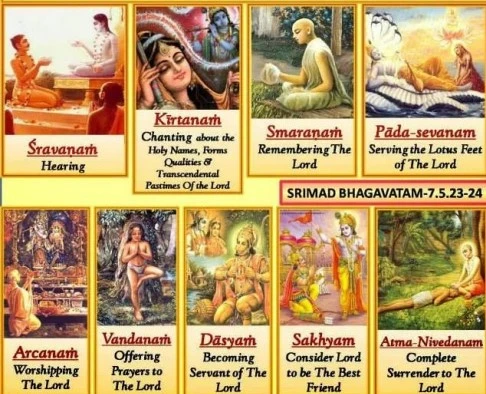“Love is the bridge between you and everything.” – Rumi
In these simple yet profound words, the renowned poet Rumi encapsulates the essence of Bhakti Yoga—the path of devotion. Love, as Rumi describes it, is not merely an emotion confined to human relationships, but a universal force that binds us to the divine, to each other, and the entire cosmos. Bhakti Yoga at its core is about cultivating this sacred bridge of love—a love that transcends barriers of time, space, and ego. It is a journey of the heart, where every thought, word, and action is infused with devotion to the divine.
In this blog post, we will delve into the depths of Bhakti Yoga, what is bhakti yoga, bhakti yoga definition,bhakti yoga poses, bhakti yoga benefits,types of bhakti yoga, and profound wisdom. Through stories, insights, and practical guidance, we will unravel the mysteries of divine love and discover how it can transform our lives.
Contents
What is Bhakti Yoga?
Bhakti Yoga is one of the four main paths of yoga outlined in Hindu philosophy, the others being Karma Yoga (the path of selfless action), Jnana Yoga (the path of knowledge or wisdom), and Raja Yoga (the path of meditation). Bhakti Yoga specifically focuses on the cultivation of love, devotion, and surrender to the divine.
In Sanskrit, “bhakti” means devotion or love, and “yoga” means union or connection. Therefore, Bhakti Yoga can be understood as the yoga of devotion or the path of loving union with the divine. Unlike some other paths of yoga that emphasize physical postures (asanas) or meditation techniques, Bhakti Yoga centers on the heart and emotions.
Understanding Bhakti Yoga in the Bhagavad Gita

भगवान कृष्ण भगवद्गीता में कहते हैं, “सब कुछ प्रेम और भक्ति के साथ मुझे अर्पित करना मेरे पास पहुंचने का मार्ग है। यह शांति और चिंता से मुक्ति प्राप्त करने के लिए सर्वोत्तम मार्ग है।” (भगवद्गीता ९.३४)
- Bhakti Yoga is all about loving God with all our hearts. It means giving everything we do, think, and feel to God, without wanting anything in return.
- Lord Krishna teaches that Bhakti Yoga is not just about doing special rituals or prayers. It’s about having a loving and selfless attitude in everything we do.
- Anyone can follow Bhakti Yoga, no matter who they are or where they come from. It’s a path of love and surrender that leads us to feel connected to God and to all living beings
Types of Bhakti Yoga

Saguna Bhakti:
This form of Bhakti Yoga focuses on worshiping and cultivating devotion to a personal form of the divine, often represented by deities such as Vishnu, Shiva, Devi (the Divine Mother), or specific incarnations like Rama or Krishna. Practitioners engage in rituals, prayers, and offerings to their chosen deity with love and reverence.
Nirguna Bhakti:
In contrast to Saguna Bhakti, Nirguna Bhakti Yoga emphasizes devotion to the formless, attributeless aspect of the divine. Practitioners of Nirguna Bhakti seek to transcend all forms and attributes to connect directly with the underlying essence of the divine, often described as Brahman or Absolute Reality. This approach may involve practices like meditation, self-inquiry, and surrender to the formless aspect of God.
Vaidhi Bhakti:
Vaidhi Bhakti Yoga, also known as Regulative Devotion, involves following prescribed rules and rituals to cultivate devotion systematically. Practitioners adhere to specific religious injunctions, such as performing daily prayers, observing religious festivals, and engaging in acts of charity and selfless service as a means to deepen their devotion to the divine.
Raganuga Bhakti:
Raganuga Bhakti Yoga or Spontaneous Devotion, is characterized by an intense and spontaneous love for the divine, often depicted in the form of divine romantic relationships, particularly with Krishna as the beloved. Practitioners of Raganuga Bhakti Yoga aspire to emulate the intimate and passionate devotion of the divine lovers (gopis) of Vrindavan, expressing their love through song, dance, and ecstatic devotion.
Gopi Bhava:
This form of Bhakti Yoga is centered on adopting the mood and sentiments of the gopis (cowherd maidens) of Vrindavan, who exemplify selfless and unconditional love for Lord Krishna. Practitioners immerse themselves in the role of the gopis, cultivating deep longing, surrender, and ecstatic love for Krishna as their divine beloved.
Nama Bhakti:
Nama BhaktiYoga or Devotion through the Repetition of the Divine Name, involves chanting or singing the sacred names (mantras) of the divine as a means of invoking and connecting with the divine presence. This practice, often referred to as kirtan or japa, is believed to purify the mind, awaken devotion, and facilitate union with the divine.
Exploring Bhakti Yoga Benefits
- Deepens Spiritual Connection: Bhakti Yoga fosters a profound sense of connection with the divine, leading to spiritual fulfillment and inner peace. Through acts of devotion, such as prayer, chanting, and meditation, practitioners cultivate a heartfelt relationship with the divine that transcends worldly concerns.
- Cultivates Love and Compassion: By focusing on love and devotion to the divine, Bhakti Yoga nurtures qualities such as compassion, kindness, and empathy towards oneself and others. Practitioners learn to see the divine presence in all beings, fostering a sense of unity and interconnectedness.
- Promotes Emotional Well-being: Engaging in devotional practices like chanting, singing hymns, and offering prayers can have a soothing and uplifting effect on emotions. Bhakti Yoga provides a safe space for expressing and processing emotions, leading to greater emotional resilience and well-being. Additionally, incorporating the practice of 4 types of pratyahara can further enhance emotional balance and well-being by directing our focus inward and fostering a sense of inner peace.
- Fosters Selfless Service (Seva): Bhakti Yoga emphasizes the importance of selfless service (seva) as an expression of love and devotion to the divine. Engaging in acts of service with a spirit of compassion and generosity cultivates humility, gratitude, and a sense of purpose in life.
- Facilitates Spiritual Growth and Evolution: By dedicating oneself to the path of Bhakti Yoga, practitioners undergo profound spiritual transformation and evolution. Through the purification of the heart and mind, they gradually transcend egoic limitations and realize their true nature as divine beings.
Bhakti Yoga Poses

- Heart-opening Poses: Heart-opening poses like Bhujangasana (Cobra Pose), Ustrasana (Camel Pose), and Setu Bandhasana (Bridge Pose) help to open the chest, expand the heart center, and cultivate feelings of love and compassion.
- Pranayama(Breath Control): 7 types of Pranayama practices such as Anulom Vilom (Alternate Nostril Breathing) and Ujjayi Pranayama (Victorious Breath) can calm the mind, balance the emotions, and deepen the connection with the divine through conscious breath awareness.
- Seated Meditation Poses: Poses like Sukhasana (Easy Pose), Padmasana (Lotus Pose), or Siddhasana (Adept’s Pose) are conducive to seated meditation, allowing practitioners to still the mind, cultivate inner peace, and deepen their spiritual practice.
- Mudras (Hand Gestures): Mudras like Anjali Mudra (Prayer Gesture) and Hridaya Mudra (Heart Gesture) can enhance feelings of devotion and connection with the divine when practiced in conjunction with Bhakti Yoga.
- Savasana (Corpse Pose): Savasana, also known as Corpse Pose, is a deeply relaxing and rejuvenating pose that allows practitioners to surrender completely, letting go of physical tension and mental distractions, and experience a sense of union with the divine.
Conclusion
In the journey of Bhakti Yoga as illuminated by Rumi’s timeless wisdom, we uncover the profound essence of love, a force that unites us with the divine and all creation. Bhakti Yoga Meaning transcends mere rituals or prayers; it entails nurturing a profound, selfless devotion to the divine, surrendering every aspect of our being with unwavering dedication.Diving into the depths of Bhakti Yoga’s definition unveils diverse paths, from Saguna Bhakti to Nama Bhakti, each offering a distinct route to deepen our connection with the divine. Along this transformative journey, we reap profound Bhakti Yoga benefits forging spiritual connection, fostering love and compassion, nurturing emotional well-being, and experiencing personal growth.
Through heart-opening Bhakti Yoga poses, breath control, meditation, and mudras, we embody the essence of devotion in our practice. Ultimately, Bhakti Yoga, as elucidated in the Bhagavad Gita, is a journey of the heart, guiding us towards unity with the divine. As we traverse this sacred path, we realize that love indeed serves as the bridge connecting us to the divine and the entirety of existence.
